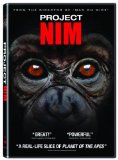| Reviews & Columns |
|
Reviews DVD TV on DVD Blu-ray 4K UHD International DVDs In Theaters Reviews by Studio Video Games Features Collector Series DVDs Easter Egg Database Interviews DVD Talk Radio Feature Articles Columns Anime Talk DVD Savant Horror DVDs The M.O.D. Squad Art House HD Talk Silent DVD
|
DVD Talk Forum |
|
|
| Resources |
|
DVD Price Search Customer Service #'s RCE Info Links |
|
Columns
|
|
|
Project Nim
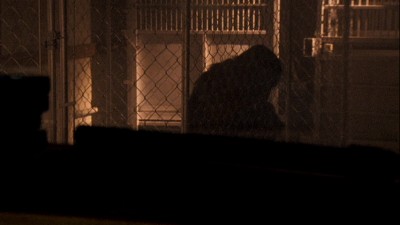
With Project Nim, director James Marsh (the underrecognized The King, and the 1980 third of the Red Riding Trilogy) follows up his popular and acclaimed 2007 best-documentary Oscar-winner, Man on Wire, with a completely different kind of story. Based on Elizabeth Hess's book Nim Chimpsky: The Chimp Who Would Be Human, the film recounts the luckless fate of the titular chimp, the "star" of a much-ballyhooed (and ultimately disappointing) linguistic experiment begun in the late '70s, whose existence was, for better or worse, persistently tampered with by humans from the moment he was taken from his mother's arms as a newborn at an Oklahoma chimpanzee breeding facility and loaned out for academic research. But just as he did with Man on Wire (and accomplishes to an even further extent here), Marsh takes what seems to be an odd, novel, isolated circumstance and finds in it all manner of recognizable human characteristics and emotional complications, taking the film well beyond superficial "quirk" and turning it into the stuff from which any good, involving drama is made. Nim may be the one the film is named after, and the idea of him hovers like a ghost around the edges of every frame, but at its core it's much less about Nim or the experiment than about the group of flawed, idealistic, ambitious, sometimes surprisingly insightful and even heroic human beings that were pulled into the orbit of the extraordinary, unfortunate chimp.

As the story is told through the film's engagingly patterned mélange of present-day interviews, re-enactments, and archival footage (unusually extensive thanks to the documentation required in a scientific-experiment situation), Nim is first pushed onto the twisted path his life would take when Columbia University linguistics professor Herbert Terrace has the bright idea of bringing up a chimp from infancy in a "human" manner, without exposure to any other chimpanzees, and using sign language to communicate with people. Professor Terrace's goal is to investigate to what degree the primate's linguistic processes and responses parallel those of a human child, creating a splash in the scientific community along the way by saying something decisive in the long-running nature/nurture argument over what distinguishes the human communication/learning pattern from that of chimps. Terrace recruits Nim's first non-chimpanzee mother, Stephanie LaFarge, a former student (and, not insignificantly, ex-lover), whom he persuades to take Nim into her and her new husband's bourgeois-bohemian Manhattan brownstone, integrating him into their large brood (both LaFarge and her spouse brought children to the marriage). When Nim comes between LaFarge and he husband and the household proves too small to accommodate two alpha mammalian males, and after LaFarge's indulgent, dedicatedly maternal (she even breastfeeds Nim) but utterly unscientific, "chaotic" approach threatens to render the experiment unverifiable and unpublishable, Terrace brings in a more rigorous teacher/caretaker, Laura-Ann Pettito, a graduate student (and, again, romantic object) of the professor's. Shortly thereafter, Terrace, with little concern for the emotional bond between Nim and the LaFarges, transfers Nim away from the raucous brownstone and into a country house on a large university-owned estate. But the now scientifically viable experiment has become less logistically feasible, with Nim growing into his natural size, strength, and aggression, and in the process sending a couple of his affectionate caretakers to the hospital with serious, gruesome bite wounds.
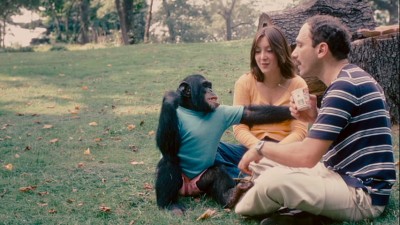
In the midst of this country-life routine, Terrace, after years of being Nim's absentee "father," abruptly decides that sufficient data has been gathered and that the time has come to end the observation period and get down to organizing and analyzing the research. This means that the increasingly unwieldy and dangerous Nim has lost his use-value and will be sent back to the breeding facility he was borrowed from, effectively destroying a chimp/human family that, after Pettito and Terrace's breakup, is comprised of Nim and his newer teachers Bill Tynan and Joyce Butler, who have themselves become a couple over the course of their work (the chimp seems to act as a strong emotional catalyst for the humans around him, both in their relationships to him and to one another). Terrace's decision-making approach is, from his point of view, less improperly emotionally invested and more appropriately scientific than that of Nim's closer caregivers, but Terrace is castigated as callous and mercenary by Tynan and Butler, who experience enormous shock, guilt, and resentment when the professor removes Nim from everything he knows and sets him off on what is to be a miserable journey through a world he's never known.
After being surrounded by so much care and attention, Nim suddenly becomes just another chimp and nothing special, and his mistreatment after being discarded only worsens when the breeding institution sells him off to an animal testing lab. Even after an advocacy effort rescues him from the lab and places him in a less deadly but still ill-suited animal sanctuary, Nim is lost, lonely, restless, and unhappy. The only person in Nim's life that has the dedication and assertiveness to mitigate his grim circumstances is Bob Ingersoll, a free-spirited, pot-smoking ex-Deadhead and research assistant who got to know Nim when he was returned to the Oklahoma facility. Ingersoll mounts a one-man crusade on Nim's behalf, diligently monitoring his whereabouts and well-being, and over time (and with the unexpected help of unlikely character James Mahoney, a scrupulous and guild-ridden vet who worked with Nim when he was a purchased lab-research subject) Ingersoll is able to provide Nim at long last with a stable, at least approximately natural, well-socialized environment. Ingersoll's efforts afford Nim a few years of peace and some semblance of freedom before he passes away in 2000, 27 years after he was taken from his birth mother.
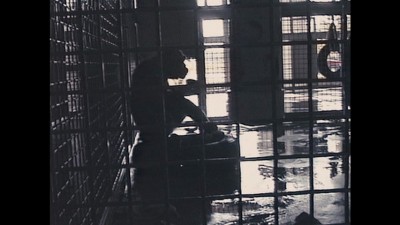
Marsh's approach as a documentarian is worlds away from the vérité, direct-cinema approach of a Barbara Kopple or an Allan King; with his beautifully lit, elegantly tracking-in/out interviews and dramatically staged and shot reenactments of many of the events described by the interviewees, he builds his film into a dramatic, present-tense narrative and is thus much more a successor of neo-documentary apostate Errol Morris. But whereas Morris's dedication to his stylizations--his graphical montages, his sometimes too-cute editing tricks, etc.--can make his films seem on occasion to be more about Errol Morris's snazziness than their ostensible subjects (e.g., the more condescending sections of his latest picture, Tabloid), Marsh's blending of his various materials (made, when not found, with the aid of cinematographer Michael Simmonds, and assembled with editor Jinx Godfrey) is designed to be unobtrusive, discouraging an under-the-microscope, detached observation and instead drawing us into a bracingly contrapuntal array of voices representing different attitudes toward and experiences of the Nim experiment. The cooperativeness, intelligence, and passion of Marsh's interviewees doesn't hurt, either; each subject is articulate and expressive in his or her own way, and the old-fashioned but inexhaustible interest of all the wrinkles and variations to be found among human personalities is something Marsh, both as interviewer and as filmmaker, has a keen eye and ear for.
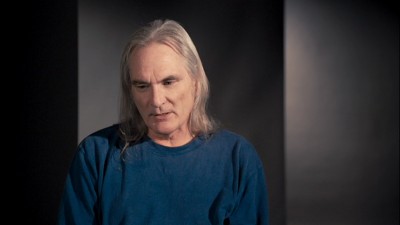
Project Nim is absolutely about the way humans treat animals and, even more deeply, about our uneasy coexistence with those non-human beings with whom we cohabit the planet--our tendency to either abuse/exploit them or naively, unfairly project our own attributes onto them. But the film raises the issue in a way that renders it infinitely more vital and dynamic than any mere lecture, reportage, or message movie could be. By capturing and playing off of each other the often contradictory impressions of a diverse group of storytellers who were all sincerely concerned with Nim's welfare (however hapless they often were when it came to bringing it about) and deeply impacted by the intersection of their lives with that of this strangely human-like animal, Marsh removes the simplistic possibility of any easy abstractions or overgeneralizations. The troubling story that the filmmakers and interviewees have to tell instead challenges us to ponder not only the obligation of humans to treat animals ethically, but the more subtle and tricky question of what the truly humane and ethical approach even is--the practical meanings of the words "humane" and "ethical. What the film imprints most deeply in the end is the urgency of arriving at a well-considered, specific answer to that question that goes far beyond the kinds of vague good intentions with which the road to Nim's limbo was sadly, predictably paved by those who cared for him and are still regretful and conscience-stricken over their failure to do better by him.
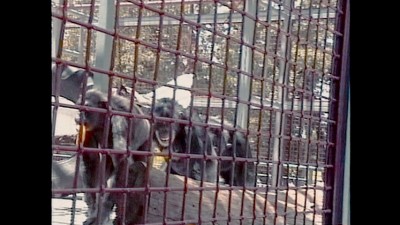
THE DVD:
The 1.78:1 aspect ratio anamorphic transfer captures, without any remarkable level of compression artifacting or over/underuse of digital noise reduction, the different super-8 and super-16 celluloid as well as old-fashioned television videotape textures that vary across the film's alternating home movie, archived broadcast, and reconstruction footage (and what appears to be either 35 mm or DV for the contemporary interviews; not being able to see the difference is surely a compliment to DP Michael Simmonds). Lionsgate has done a really nice job of preserving the film's visual integrity for the home viewing experience.
Sound:The Dolby Digital 5.1-EX soundtrack is vivid, clear, and strong. The sound resonates beautifully when it comes to both the interviewees' voices and the musical score (the two elements constituting the bulk of the film's soundscape), and there are no distortions or imbalances whatsoever, with a full and rich dimensionality throughout.
Extras:--A feature-length audio commentary with director James Marsh, which he inaugurates by confessing some anxiety, as he never watches his films once he's completed them and worries that he'll only find things he wishes he could change. But he manages quite well as he amiably comments on the aesthetic choices he made, his aims for a kind of objectivity, and his focus away from the scientific implications of the Nim project and onto the dramas, flaws, and emotions that emerge from the tangled web of its human participants. Marsh also offers some insight into the tough research, investigation, and sometimes begging (James Mahoney, the animal researcher/veterinarian, took some long-term convincing before he would participate) required when putting together a documentary like this, and he seems well cognizant of his great good fortune as a filmmaker to have been able to round up all the main human players in Nim's life, and that those people had so much of their own documentation that they were willing to share in addition to their on-camera recollections to make the film the expansive, complex, simultaneously warm and disturbing experience it is.
--"Bob's Journey," a 10-minute piece regarding the involvement of former research assistant/Nim rescuer-advocate Bob Ingersoll in both the film and its promotion, with footage of Ingersoll following the film, along with director Marsh and producer Simon Chinn, to its many festival screenings around the world. The unfailingly enthusiastic yet mellow Ingersoll visits an English chimp refuge, speaks about the impact of Project Nim on his life (his parents finally came to respect and understand his work with chimpanzees), and generally comes across as the film's true hero, a remarkably selfless and guileless, salt-of-the-earth figure who contributed enormously to the film's power to move us and continues to elicit our goodwill (and maybe even a few tears) here.
--Making Nim, a half-hour featurette (done in the style of the film itself) in which most of the principal creative team--director James Marsh, producer Simon Chinn, director of photography Michael Simmonds, Nim Chimpsky: The Chimp Who Would Be Human author Elizabeth Hess, expert chimp impersonator Peter Elliott, and composer (and founding member of The Tindersticks) Dickon Hinchliffe--discuss the origins of the project and the process of drawing a narrative out of the story. That involved a surprising degree of resourcefulness and work in creating the reenactments, as well as ingenuity when it came to weaving that material seamlessly into the original, archival documentation; much of the process is shown here in fairly detailed behind-the-scenes footage. The featurette concludes on scenes shot at various film festivals, where the film and whatever participants have been recruited to help present it are warmly received.
--The film's theatrical trailer, along with a group of additional previews for Lionsgate films.
FINAL THOUGHTS:Insofar as it does clearly pose the troubling ethical and moral questions raised by the experiment that brought its human subjects into contact with the chimp of the title, Project Nim can be said to be "about" the experiment. But the most fascinating behavior in the film by far is that which the people reveal themselves, not the animal, to have engaged in. Their motivations, logic, and obsessions, their dealings with each other and with Nim, are interesting for uniformly floating somewhere in the no-man's-land between unequivocally laudable and downright egregious; not since Mike Leigh's Another Year has a film so successfully avoided black-and-white judgment to build dramatic interest and tension out of various shades of grey. Director James Marsh confidently and skillfully applies a variety of nonfictional and semifictional techniques to the material, creating juxtapositions of rough and smooth textures (both cinematically and character-wise) that create a kind of emotional suspense, keeping us perpetually invested as we seek to discover where, as he was passed down the line of all his more or less well-meaning caretakers, Nim's categorical status (animal or human? scientific subject, pet, child, family member, or transferable property?) got so muddled, the fulfillment of his own simple needs and animal identity so lost. It's a sad movie, sometimes a devastating one, but it's also tremendously absorbing (all those vibrant, distinctive personalities offering their frequently contradictory version of events!) and not without its hard-won glimmers of hope and encouraging examples of people who are big enough to admit they made mistakes. Marsh has pulled off a fairly exceptional feat with Project Nim; few fictional films manage to be this engrossing on the dramatic level, and few documentaries make such a seemingly theoretical, distant problem hit so provocatively, compellingly close to home. Highly Recommended.
|
| Popular Reviews |
| Sponsored Links |
|
|
| Sponsored Links |
|
|
| Release List | Reviews | Shop | Newsletter | Forum | DVD Giveaways | Blu-Ray | Advertise |
|
Copyright 2024 DVDTalk.com All Rights Reserved. Legal Info, Privacy Policy, Terms of Use,
Manage Preferences,
Your Privacy Choices | |||||||









